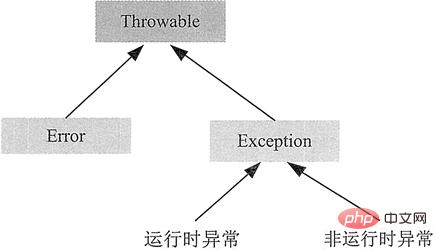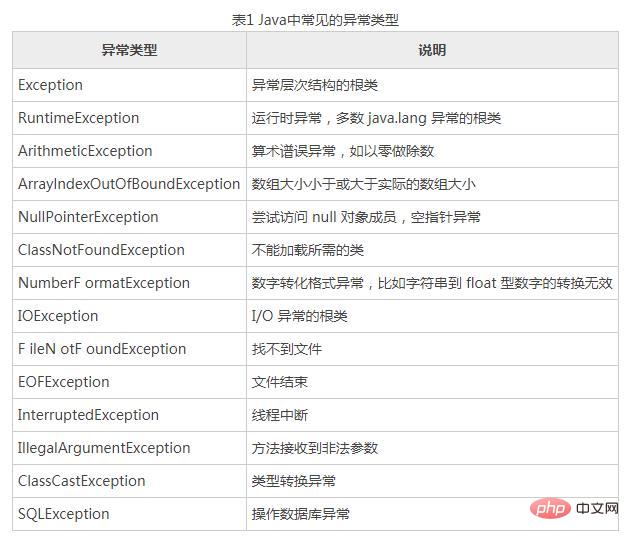
Exception refers to an error that occurs during the running of the program. It occurs during the running of the program.
Exception in Java, also known as exception, is an event that occurs during program execution, which interrupts the normal instruction flow of the executing program. In order to handle running errors in the program promptly and effectively, exception classes must be used. [Recommended learning: java course]
Causes and usage principles of exceptions
In Java, there are three main reasons for an exception to occur: One reason:
Java internal error exception occurred, an exception generated by the Java virtual machine.
Exceptions caused by errors in the program code written, such as null pointer exceptions, array out-of-bounds exceptions, etc. This kind of exception is called an unchecked exception, and it is generally necessary to handle these exceptions centrally in certain classes.
Exceptions generated manually through the throw statement are called checked exceptions and are generally used to inform the caller of the method some necessary information.
Java handles exceptions through an object-oriented approach. During the running of a method, if an exception occurs, the method will generate an object representing the exception and hand it to the runtime system. The runtime system will look for the corresponding code to handle the exception.
We call the process of generating an exception object and submitting it to the runtime system as throwing an exception. The runtime system searches the method's call stack until it finds an object that can handle that type of exception. This process is called catching the exception.
Java exceptions force users to consider the robustness and security of their programs. Exception handling should not be used to control the normal flow of the program. Its main function is to capture exceptions that occur when the program is running and handle them accordingly. When writing code to handle exceptions that may occur in a certain method, you can follow the following three principles:
Use try catch statements in the current method declaration to catch exceptions.
When a method is overridden, the method that overrides it must throw the same exception or a subclass of the exception.
If the parent class throws multiple exceptions, the overriding method must throw a subset of those exceptions and cannot throw new exceptions.
Exception type
All exception types in Java are subclasses of the built-in class java.lang.Throwable class, that is, Throwable is located in the exception The top level of the class hierarchy. There are two exception branches, Exception and Error, under the Throwable class, as shown in Figure 1.

Figure 1 Exception structure diagram
The Throwable class is the super class of all exceptions and errors. There are two subclasses below: Error and Exception, which represent errors and exceptions respectively. Among them, the exception class Exception is divided into runtime exception and non-runtime exception. There is a big difference between these two exceptions, also called unchecked exception (Unchecked Exception) and checked exception (Checked Exception).
The Exception class is used for exceptions that may occur in user programs. It is also a class used to create custom exception type classes.
Error defines exceptions that are not expected to be caught by the program under normal circumstances. Exceptions of type Error are used by the Java runtime to display errors related to the runtime system itself. Stack overflow is an example of this error.
This chapter does not discuss exception handling of the Error type, because they are usually catastrophic and fatal errors that are beyond the control of the program. The remainder of this chapter discusses exception handling of the Exception type.
Runtime exceptions are exceptions of the RuntimeException class and its subclasses, such as NullPointerException, IndexOutOfBoundsException, etc. These exceptions are unchecked and can be captured or not processed in the program. These exceptions are generally caused by program logic errors, and the program should try to avoid the occurrence of such exceptions from a logical perspective.
Non-runtime exceptions refer to exceptions other than RuntimeException, and they all belong to the Exception class and its subclasses. From the perspective of program syntax, it is an exception that must be handled. If it is not handled, the program will not be compiled. Such as IOException, ClassNotFoundException, etc. and user-defined Exception exceptions. Generally, no custom checked exceptions are used. Table 1 lists some common exception types and their functions.

The above is the detailed content of What is exception in java?. For more information, please follow other related articles on the PHP Chinese website!